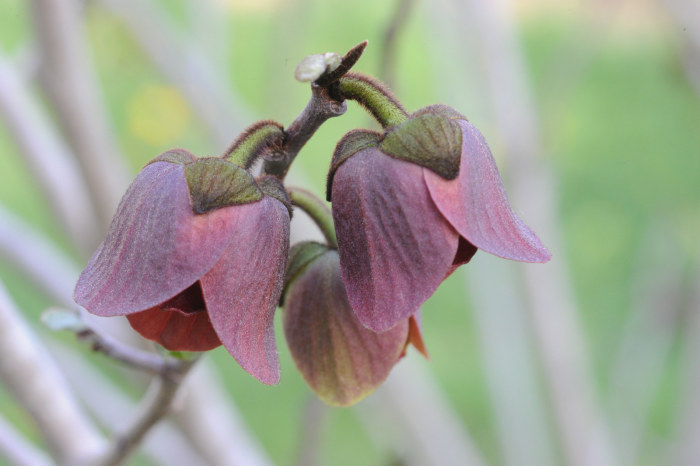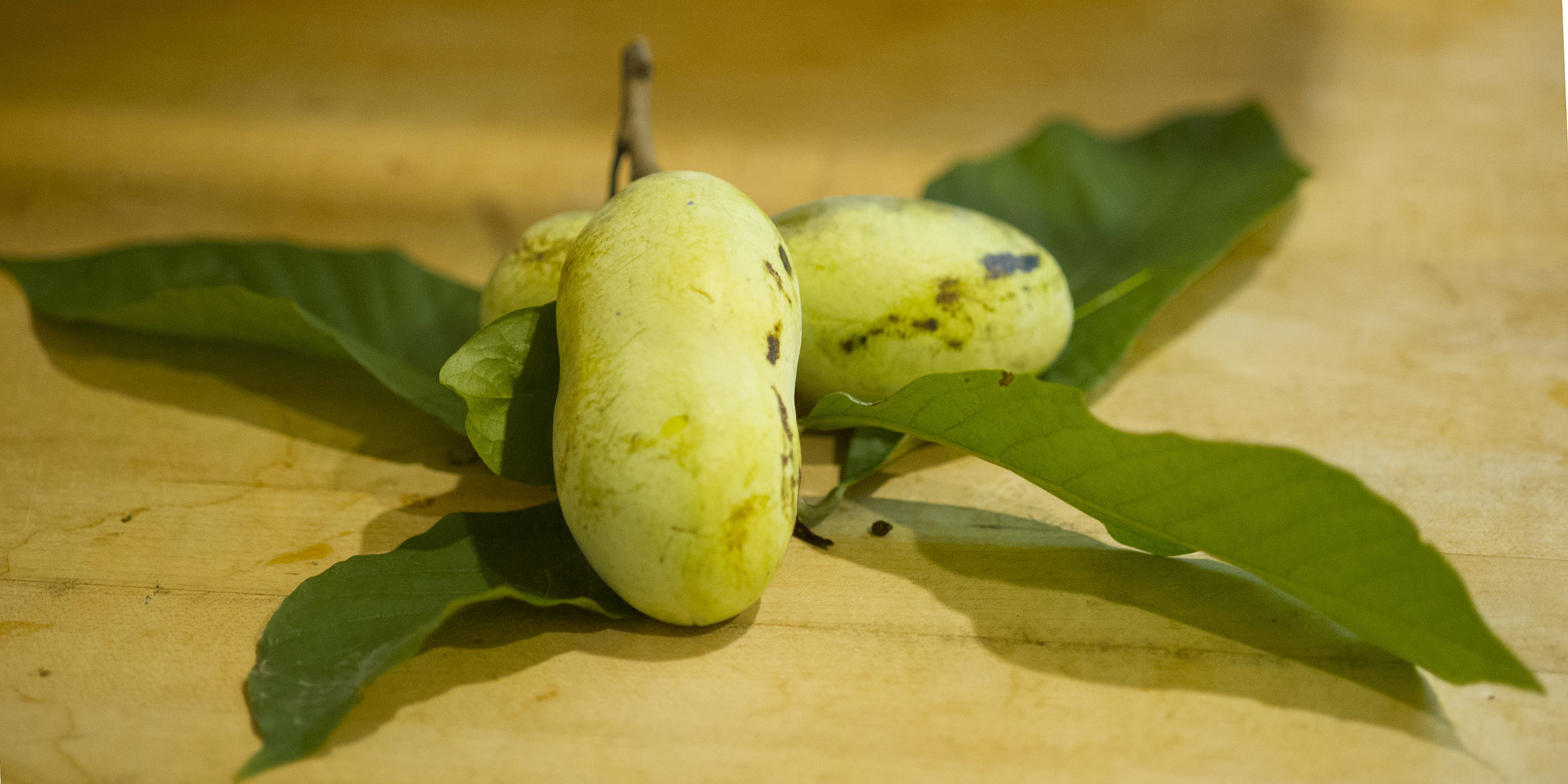Lora Conrad features pawpaw, a tree that grows in a few southeast Iowa counties, provides “wonderful fruit,” and is a preferred food source for the Zebra Swallowtail caterpillar. -promoted by Laura Belin
Yes, there are pawpaws in Iowa.
Where do Pawpaws grow?
The Pawpaw (Asimina triloba) bears the largest edible fruit indigenous to North America right here in Iowa. This small tree is native to 26 states. However, Iowa is on its northern most range. Here the Pawpaw grows in the wild only in a few counties along the Mississippi River and along Iowa’s southern edge. See the BONAP map for details. A small grove of native pawpaws grow in Shimek State Forest along Lick Creek. (Shimek Forest is in Lee and Van Buren Counties.) They also grow well here in Van Buren County planted in the garden or yard.
Individual fruit can be from a couple of inches up to 8 inches long, though most are about 3 to 4 inches. The ones shown here, grown in Van Buren County, are about 5 inches.
Why would you want to find them or grow them?
In addition to the wonderful fruit, you will be rewarded with a lovely small tree, some fascinating blossoms, and a preferred food source for the Zebra Swallowtail caterpillar!
How do you identify one?
The Pawpaw is a small tree or shrub with large leaves as shown below. In the wild in crowded conditions, it can get tall and thin seeking light. The leaves are tropical in appearance, large and a rich green. The leaves have an unpleasant aroma that you will not forget once smelled—a chemical smell designed to warn off potential predators. You will find little damage to the leaves—any damage perhaps means a zebra swallowtail caterpillar has dined there.
Deer usually find pawpaw leaves and shrubs unpalatable. That is because the bark and foliage contain acetogenins, a natural insect repellent, which gives them an unpleasant taste as well as that characteristic smell. (You won’t like the taste of the leaves either.)
What about blooming and fruit production?
In early spring—sometimes as early as the end of March to the middle of May, the buds will begin to emerge from their winter protection. First—an interesting green blossom:
This image is a tree with blossoms in varying stages of green to burgundy, before the leaves peek out..
The blossoms slowly turn to a deep burgundy—reminiscent of the wild ginger blossom.
By this time, all the blossoms are burgundy and the leaves are coming out. If you are very lucky, this is after the last frost.
The tree will have many blossoms, but since the plant is not self fertile, you will need two different varieties to have pollinated fruit. This difficulty in pollination means a light fruit crop (unless set by hand techniques).
As the blossoms fall and you see the fruit begin to grow, there will often be four individual fruit set from one blossom. This is at least some compensation for the small number that will be pollinated at all.
In three weeks the fruit has grown.
It is well hidden among the leaves.
By August, the fruit are almost full size but green and hard—and no aroma.
By early September, they are changing color and looking plumper and still often hold up to four per cluster. Now there is a serious race. How soon will the whiff of wonderful aroma attract the raccoons or possums to the tree? Some authors say that foxes and squirrels are also attracted to them. (I’ve found it best to put a temporary electric fence around any Pawpaws bearing fruit.)
These extra large fruit are almost as long as the leaves nearby.
When the fruit has a more yellowish cast, feels like it is softening to the touch, and has its faint but wonderful tropical aroma—pick it!! Fast! The stems will release easily if ripe. Fruit will fall soon after ripening and are often taken well before fully ripe by raccoons, etc.
Eating those Pawpaws
They continue to ripen after being picked and will darken like a banana, though they are still edible as they darken. They will darken more quickly if refrigerated, although they will keep much longer refrigerated.
When to eat them is a matter of taste. It’s similar to how ripe do you like bananas? The taste, to me, is most like a mango-banana cross. The texture is soft, which is why pawpaw is also called a “custard apple” in some areas. In my rush to process and enjoy the fruit, I failed to make a picture of the inside of the fruit. This one is from Baker Creek Heirloom Seeds, where you can purchase seeds.
To eat one that is ripe, softening and has a few dark spots, peel the fruit with a sharp paring knife—removing all the peeling. Then slice across making a slice thinner than a seed. The fruit should be soft. Remove each seed from its little casing as you go as it is part of the edible flesh. Set aside the several large dark seeds. Enjoy the sliced fruit without any salt, or sugar or other additions. That is how they are best.
Some people eat them right off the tree, but it still takes a knife to get one open as you will not want want to bite into the peeling. Never eat the seeds nor peeling. Your seed collection grows quickly .
Two points about eating them.
If you eat one too green, the taste is flat and astringent—might remind you of eating a green persimmon. Secondly, even when fully ripe, the quality of wild pawpaws and pawpaws grown from seed can vary greatly. As stated at Kentucky State University’s site: “Most pawpaws taste good, some are truly wonderful, and a few are better for throwing than for eating.” Commercial varieties are mostly in the tastes “wonderful” category.
If you are lucky enough to have extra pawpaw fruit, removing the pulp and freezing it is easy to do. Then you have it for its best possible use (in my opinion) – pawpaw ice cream! Just make any vanilla custard-style ice cream base and add up to 2 cups of pawpaw pulp, freeze as usual. Enjoy.
Want to know more about Pawpaws?
Kentucky State University has the only full-time pawpaw research program in the world. It is a marvelous resource for growing and using the Pawpaw. The site includes detailed instruction on growth and production as well as an excellent collection of recipes.
Want to grow your own or just buy some to eat?
Since pawpaws are found in only a few counties in Iowa in the wild, you might want to grow your own as they will generally grow in Zone 5 and points south. In the wild, the trees spread by both suckering from the roots and from seeds. The root sprouting led to the common term “Pawpaw patch” as they will quickly develop young sprouts as far out as their roots reach, which after a few years may be more than 25 feet from the original tree.
They can be propagated by seed, provided the seeds do not dry out. Never dig one up in the wild, as it will most often die as well as deprive nature of a not often found species here in Iowa. When it grows from a seed, that two foot tall shrub will have a tap root way deeper than it is tall—meaning you will almost certainly break it and assure its death. When a root sprout, its own root structure will be too weak to support it well. If it survives, it will still take as long to bear as one grown from seeds—that is four to eight years. For full details on how to propagate, including transplanting from home grown seed or root sprouts, see “Pawpaw Planting Guide.”
A commercial orchard, Red Fern Farm in Wapello, Iowa sells fruit and trees when available.
Here is an example of their sprouting under a tree. Note all the different sizes-small to young trees.
Now, just for fun—the quirks and lore of “pawpaw”
Songs about them include “Paw Paw Patch,” a traditional American folk song. 
Disney’s The Jungle Book “Bare Necessities” confusingly conflates pawpaws, prickly pears, and pears. The Nigerian singer Zlatan released a new song in 2020 called “Unripe Pawpaw.”
Places in the United States named Paw Paw include towns or communities in Illinois, Kentucky, Michigan, Missouri and West Virginia. In addition several townships, lakes, a river, several high schools, and a tunnel are named Paw Paw.
The explorers Meriwether Lewis and William Clark were known to have survived primarily on pawpaws for about a month.
Then lets don’t forget the term of affection for grandfathers—yes–”pawpaw” used in many Southern states. You can order your greeting card for Pawpaw from Greeting Card Universe.
The compounds called Annonaceous acetogenins found within the bark, seeds and leaves contain anti-cancer properties as well as pesticidal properties. Extensive research has been done on these and a lice-fighting shampoo is on the market.
So—Happy Pawpaw Hunting—- and may you find yourself “way down yonder in the paw paw patch” one day!



















4 Comments
PawPaw's are delicious
Thank for this article. It brings back great memories. While growing up in eastern Kentucky we had a PawPaw tree in our year next to a living room window on the east side of the house. I never saw another PawPaw tree anywhere else. Thank for this article. It brings back great memories.
RetiredVeteran Wed 26 Aug 12:12 PM
Thanks for feedback.
A good protected spot for the tree–if like us in Alabama, there was probably a fig tree in another protected corner of the house.
LPConrad Wed 26 Aug 12:29 PM
I didn't know the flowers were so beautiful
I saw a few wild pawpaws in southwest Michigan long ago (there were a fair number of wild pawpaws in that part of the state, and that’s where the town of Paw Paw is located). But I never saw one in bloom. Gorgeous blossom. I appreciate these photos and information — so much I didn’t know. Thank you!
PrairieFan Thu 27 Aug 1:23 PM
Thnak You
Glad you enjoyed it. Yes–I love the blossoms.
LPConrad Fri 28 Aug 10:38 PM